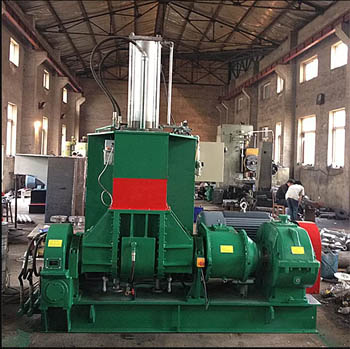In the chemical ,plastic,rubber industries, in order to achieving uniform mixing and dispersion of high-viscosity materials is very critical for further processing.
Kneader machine , also named as Banbury mixers or intensive mixers , they are becoming indispensable processing machine and a must-have for any chemical production facility.
The kneading machine are mainly used for blending, kneading, and dispersing complex formulations, they are applicable to plastic , adhesive , color master batch, polymers, rubber compounds, adhesives, and sealants and high-viscosity materials .
Therefore , one of the most important thing is that understanding processing weight capacity for each size kneader machine per batch
,so that we know how to select the right capacity internal mixer machine .
As choosing the right capacity internal mixer ensures efficient production, consistent quality, and optimal energy usage.
What is Processing Weight in an Internal Mixer?
The processing weight of material (in kilograms) that the internal mixer or kneader can handle per cycle or batch . Usually the processing material is different ,it depend on several factors as follows:
* Mixing chamber volume (L)
* Material bulk density (kg/L)
* Rotor design and speed
Filling factor (the percentage of the chamber that can be effectively filled, usually 0.6–0.8).
Standard Processing Weight by Internal Mixer Size
1. Small Volume Lab Kneader ( Laboratory Internal Mixer )
Here ,let us explore their standards weight different internal mixer in different sizes for rubber and silicone processing as follows:
Let us firstly talk the lab kneader .
Small volume lab kneaders are designed for research, testing, and small-batch production , they are ideal for small samples and precise experimental control. Usually ranging from 0.5 L to 10 L,
They are mainly used in these industries :
* Laboratory R&D in various institute
* Material testing and formulation development (chemical ,rubber , plastic ,silicome , polymer and other high-viscosity material)
* Educational use for universities & academcy
1–2L Laboratory Internal Mixer
* Chamber Volume: 1–2 liters
* Batch Weight: ~0.8–2 kg per batch
5L Pilot Internal Mixer
* Chamber Volume: 5 liters
* Batch Weight: ~3–4.5 kg per batch
While large industrial kneaders are built for continuous, high-volume production ,their capacities ranging from 35 L up to over 150 L, . They are used in: Rubber & tire manufacturing ,Plastic compounding , Food industry so on .
35L Industrial Dispersion Kneader
* Chamber Volume: 35 liters
* Batch Weight: ~25–28 kg per batch
75L Standard Production Dispersion Kneader
* Chamber Volume: 75 liters
* Batch Weight: ~55–60 kg per batch
110L and Above Kneader (Heavy-Duty Production)
* Chamber Volume: 110 liters or larger
* Batch Weight: ~80–90 kg and higher per batch
Several Factors That Influence Batch Weight of Kneader :
* Material Density: For the same chamber capacity or size , the rotor would mix and blend lower batch weight for the higher-density compound material each batch .
* Fill Factor: Usually ,the batch weight is appro 60-80% of the total capacity of chamber , so that the inner rotor can mix and blend the compound material uniformly and fully but avoid overloading .
* Rotor Type: There are different rotors design for choice , typically Tangential vs. intermeshing rotors affect mixing efficiency and weight tolerance.
* Cooling System: Control the temperature effectively and precisely can allow higher batch weights without scorching.
Thus , selecting the right kneader capacity size is based on processing batch weight that we need . Whether you use the kneader internal mixer for laboratory testing or full-scale manufacturing ,that is very critical to make decision.
From compact 1–2L lab mixers to heavy-duty 110L production internal mixers, understanding the relationship between chamber volume, material density, and batch weight ensures optimal mixing performance and consistent final products.
For these small volume lab dispersion kneaders ,they excel in R&D and formulation testing, while for large size industrial kneaders , they are the perform good helper for high-volume, consistent mass production.
No matter you need lab kneader or industrial dispersion ,we can tailored high quality Kneader for you .
Kneader for you Need !
Talk with Simptek Now .







